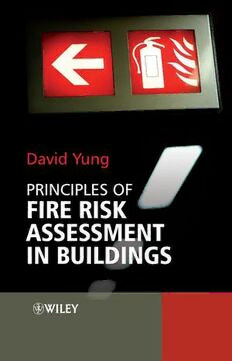
Principles of Fire Risk Assessment in Buildings PDF
Preview Principles of Fire Risk Assessment in Buildings
Principles of Fire Risk Assessment in Buildings Principles of Fire Risk Assessment in Buildings David Yung © 2008 John Wiley & Sons, Ltd. ISBN: 978-0-470-85402-0 Principles of Fire Risk Assessment in Buildings David Yung Yung& AssociatesInc., Toronto, Canada A John Wiley and Sons, Ltd, Publication Thiseditionfirstpublished2008 2008JohnWiley&Sons,Ltd Registeredoffice JohnWiley&SonsLtd,TheAtrium,SouthernGate,Chichester,WestSussex,PO198SQ, UnitedKingdom Fordetailsofourglobaleditorialoffices,forcustomerservicesandforinformationabout howtoapplyforpermissiontoreusethecopyrightmaterialinthisbookpleaseseeour websiteatwww.wiley.com. Therightoftheauthortobeidentifiedastheauthorofthisworkhasbeenassertedin accordancewiththeCopyright,DesignsandPatentsAct1988. Allrightsreserved.Nopartofthispublicationmaybereproduced,storedinaretrieval system,ortransmitted,inanyformorbyanymeans,electronic,mechanical,photocopying, recordingorotherwise,exceptaspermittedbytheUKCopyright,DesignsandPatentsAct 1988,withoutthepriorpermissionofthepublisher. Wileyalsopublishesitsbooksinavarietyofelectronicformats.Somecontentthatappearsin printmaynotbeavailableinelectronicbooks. Designationsusedbycompaniestodistinguishtheirproductsareoftenclaimedas trademarks.Allbrandnamesandproductnamesusedinthisbookaretradenames,service marks,trademarksorregisteredtrademarksoftheirrespectiveowners.Thepublisherisnot associatedwithanyproductorvendormentionedinthisbook.Thispublicationisdesignedto provideaccurateandauthoritativeinformationinregardtothesubjectmattercovered.Itis soldontheunderstandingthatthepublisherisnotengagedinrenderingprofessionalservices. Ifprofessionaladviceorotherexpertassistanceisrequired,theservicesofacompetent professionalshouldbesought. Disclaimer NeithertheauthornorJohnWiley&SonsLtdacceptanyresponsibilityorliabilityforlossor damageoccasionedtoanypersonorpropertythroughusingthematerials,instructions, methodsorideascontainedherein,oractingorrefrainingfromactingasaresultofsuchuse. LibraryofCongressCataloging-in-PublicationData Yung,DavidTinLam. Principlesoffireriskassessmentinbuildings/DavidTinLamYung. p.cm. Includesbibliographicalreferencesandindex. ISBN978-0-470-85402-0(cloth)–ISBN978-0-470-85409-9(pbk.:alk.paper) 1. Fireriskassessment. I. Title. TH9446.3.Y862009 363.37(cid:1)6–dc22 2008043731 AcataloguerecordforthisbookisavailablefromtheBritishLibrary. ISBN:978-0-470-85402-0(Hbk) 978-0-470-85409-9(Pbk) Typesetin10.5/13SabonbyLaserwordsPrivateLimited,Chennai,India PrintedandboundinGreatBritainbyTJInternational,Padstow,Cornwall Contents AbouttheAuthors ix Preface xi Acknowledgments xiii ListofSymbols xv 1 Introduction 1 PARTI SimpleApproachtoFireRiskAssessment 5 2 WhatisFireRiskAssessment? 7 2.1 Overview 7 2.2 WhatisFireRiskAssessment? 7 2.3 Summary 15 2.4 Review Questions 16 References 16 3 FireRiskAssessmentBasedonPastFireExperience 17 3.1 Overview 17 3.2 BasedonPastFireExperience 18 3.3 BasedonFireIncidentData 23 3.4 Summary 29 3.5 Review Questions 30 References 30 vi Contents 4 Qualitative FireRiskAssessment 33 4.1 Overview 33 4.2 RiskMatrix 34 4.3 ChecklistMethod 36 4.4 Event-TreeMethod 42 4.5 Summary 46 4.6 Review Questions 47 References 47 5 Quantitative FireRiskAssessment 49 5.1 Overview 49 5.2 RiskIndexing 50 5.3 ChecklistMethod 50 5.4 Event-TreeMethod 55 5.5 Summary 60 5.6 Review Questions 61 References 62 PARTII FundamentalApproachtoFireRiskAssessment 63 6 FundamentalApproachtoFireRiskAssessment 65 7 FireGrowthScenarios 71 7.1 Overview 71 7.2 CompartmentFireCharacteristics 72 7.3 FireModelInputandOutputParameters 76 7.4 DesignFires 80 7.5 AutomaticFireSuppressiontoControlFireGrowth 89 7.6 Summary 91 7.7 Review Questions 92 References 93 8 FireSpreadProbabilities 95 8.1 Overview 95 8.2 FireResistantConstruction 96 8.3 ProbabilityofFailure 100 8.4 FireSpreadProbabilities 106 8.5 Summary 110 8.6 Review Questions 111 References 112 Contents vii 9 SmokeSpreadScenarios 113 9.1 Overview 113 9.2 SmokeSpreadCharacteristics andModelling 114 9.3 SmokeControlSystemstoClearSmokein Evacuation Routes 124 9.4 Summary 129 9.5 Review Questions 130 References 130 10 OccupantEvacuationScenarios 133 10.1 Overview 133 10.2 OccupantEvacuationCharacteristics andModelling 134 10.3 OccupantSafetyMeasures toExpediteOccupant ResponseandEvacuation 150 10.4 Summary 157 10.5 Review Questions 157 References 158 11 FireDepartmentResponse 161 11.1 Overview 161 11.2 FireDepartmentResponseTimeandResources 162 11.3 OccupantFatalityandPropertyLossModelling 175 11.4 FireProtectionMeasurestoProvideEffective OccupantRescueandFireExtinguishmentEfforts 180 11.5 Summary 182 11.6 Review Questions 184 References 185 12 UncertaintyConsiderations 187 12.1 Overview 187 12.2 WhatAretheUncertainties? 188 12.3 TreatmentofUncertainty 190 12.4 Summary 200 12.5 Review Questions 200 References 201 13 FireRiskManagement 203 13.1 Overview 203 13.2 FireRiskManagement 204 13.3 AlternativeFireSafetyDesigns 206 viii Contents 13.4 ImpactofInspectionandMaintenance onSystem Reliability 213 13.5 ImpactofEvacuationDrillsonEarlyOccupant ResponseandEvacuation 220 13.6 Summary 220 13.7 Review Questions 222 References 222 Index 225 About the Author The author is currently the President of his own consulting company, Yung & Associates Inc. He has worked in fire research and fire risk assessment for over 20 years. From 2002 to 2006, he was Research Leader of Fire Science at the Australian national research organization CSIRO in Sydney, Australia. Before that, he was a Senior Research Officer and Group Leader of Fire Risk Assessment for 17 years at the National Research Council Canada (NRCC) in Ottawa. He led a team that developed one of the world’s comprehensive fire risk-cost assessment models, called FiRECAM. Before joining the fire research group at NRCC in 1985, he spent seven years at the Argonne National Laboratory in the USA, and three years at the Chalk River Nuclear LaboratoryandNRCC,conductingnuclearandsolarenergyresearch. Theauthor’sworkismentionedinthebookHistoryofFireProtection Engineering, published in 2003 by the National Fire Protection Asso- ciation (NFPA) and the Society of Fire Protection Engineers (SFPE) in the USA. He is a member of the NFPA Technical Committee on Fire Risk Assessment Methods. In September 2003, he was given the ‘Hats Off’ award by SFPE for his service as the Editor-in-Chief ofthe Journal of Fire Protection Engineering. In May 2001, he was elected a Fellow of the SFPE for his achievement in fire protection engineering. He has over100publicationsinfire,nuclearandsolarenergy,anddesalination andwaterpurification. Heservesontheeditorial boardsofthreemajor international fire journals and is the past Editor-in-Chief of the Journal ofFireProtectionEngineering. x AbouttheAuthor He holds a B.Eng. from McGill University, an M.A.Sc. from the Uni- versityofToronto,andaPh.D.fromMIT,allinmechanicalengineering. In addition, he is a licensed professional engineer in the Province of Ontario, Canadaand amember oftheAmerican Society ofMechanical Engineers. Preface The concept for this book originated in late 2001 when John Wiley & Sons Inc. approached me with a proposal to write a book on fire risk assessment.Atthattime,IwasaSeniorResearchOfficerattheNational Research Council Canada (NRCC) and had conducted research on fire risk assessment for 15 years. I was happy to accept the challenge to writeabookbasedonmyobservationsandresearchfindingsonfirerisk assessmentovertheyears. Shortlyafteragreeingtowritethebook,Iacceptedaninvitationfrom CSIRO in Australia to lead their fire science group. Working in a new organization and living in a new country, however, did not permit me much time to work on a book–hence, it wasn’t until I returned to Canadain2006thatwritingbeganinearnest. My involvement in fire risk research was preceded by a number of years in energy research. I had spent time at the Argonne National Laboratory in Chicago working on thermal hydraulic issues related to nuclear reactor safety, and heat transfer issues related to Ocean Thermal Energy Conversion in Hawaii. I also spent time at the Chalk RiverNuclearLaboratoryworkingonheattransferissuesrelatedtothe Canadian CANDU reactor; and later at NRCC conducting research in solar energy. The cessation of government funding for energy research in1985resultedinacareerchangetofireresearch,inparticularfirerisk assessmentresearch. Myinterestinfireriskassessmentresearchwasinfluencedbytwoindi- viduals.ThefirstwasProfessorVaughnBeckoftheVictoriaUniversityof TechnologyinAustraliawhospenttimeonsabbaticalatNRCCinearly 1987.His great enthusiasm forthe development ofcomputer-based fire riskassessmentmodelswascontagious.ThesecondwasKenRichardson whowas,atthattime,theAssociateHeadofNationalFireLaboratoryat
